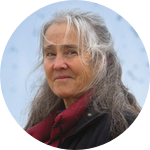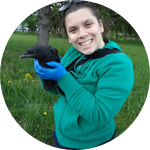About This Project
Large flocks of American Crows (Corvus brachyrhynchos) form across Upstate New York each winter, eating in fields by day, gathering—and defecating—in urban roosts at night. Roosts can contain tens of thousands of crows, and can connect rural and urban habitats in important ways. We will study crows’ ecological impact on the landscape, specifically the movement of nutrients through fecal nitrogen deposited under roosts.Ask the Scientists
Join The DiscussionWhat is the context of this research?
Nitrogen is a key nutrient, but also a potential pollutant that naturally cycles globally between soils, water and air. Large urban areas can disturb natural cycling processes—they may become islands with few inputs or abnormally high concentrations. Either will disrupt natural cycling based on plants and microbes.
This project will investigate the importance of American crow (Corvus brachyrhynchos) feeding and roosting behavior in moving nitrogen across the landscape from natural and human-created food sources (e.g. rural agriculture and landfills) to “hot spots” of deposited nitrogen under roosts in urban forests. The roosts and resulting “hot spots” are likely to play a key role in the nutrition of urban plants and in the microbial processes that underlie the “biogeochemical cycles” occurring in our urban areas. The study of nutrient cycles in cities is in its early stages, but understanding them is key to designing healthy, ecologically sustainable urban environments.
What is the significance of this project?
Global changes in biodiversity and in biogeochemical cycles are two great challenges to sustainability of life in the 21st century. Our study links these challenges by connecting the natural behavior of animals to the biogeochemistry of a complex, urban-impacted landscape. Upstate New York is a patchwork of growing small-medium cities, rural agriculture and regenerated forest.
The research is grounded in a unique collaboration between ecosystem ecologists, Ben Eisenkop and Dr. Weixing Zhu and animal ecologists Dr. Anne B. Clark and Dr. Kevin J. McGowan. Drs. McGowan and Clark direct a 25-year population study of banded crows in Ithaca NY while Ben Eisenkop and Dr. Zhu will conduct the ecosystem study of soil nitrogen below roosts.
Ben’s research so far has identified a set of winter roosts ranging from large and traditional (10-50 thousand birds and used yearly) to small and transitory (<1000 birds and shifting year to year). We have demonstrated and worked out the methods for sampling and analyzing nitrogen and N-processing in soils below roosts year round.
The data produced by our study will demonstrate what role migratory bird movements play in the nutrient cycling between these areas, generating important data for understanding human-nature interactions in medium sized cities. A study of an iconic, familiar bird and the local parks or forests will also provide unique opportunities for environmental education at all levels.
What are the goals of the project?
To identify communal roosts in Ithaca, we will capture and fit 15-20 crows with radio-transmitters in fall of 2014. An additional 10-15 (to a total of 30 crows) will be tagged in Jan 2015 while migrants are present. The goal is to sample the movements and roost use of local crows year around as well as the winter movements of migrant crows.
Crows are trapped either in a drop-in trap, or using our remotely-triggered net (Net-Launcher) to capture specific families on territory. Clark and collaborator McGowan have used both methods successfully over the past decade for various behavior studies.
Captured birds are banded and given uniquely lettered wing tags for distance recognition. For radio tracking, birds are fitted with transmitters (wt. 6-10 g or <3% of the crow’s weight per USGS Bird Banding Lab guidelines) secured with a hand-fitted, back-pack style harness. All banding and radio-tagging is done under USGS and New York State permits to K. J. McGowan and all crow handling and observations are covered by IACUC protocols to Clark and McGowan. Tracking is done from vehicles with rooftop antennae connected to scanning receivers capable of efficiently moving through the set of radio frequencies. Repeat follows of individuals will reveal how regularly roosts are occupied and serve to identify more roosts. The habitat characteristics of roost sites will be quantified and their geographic characteristics recorded.
We will select three winter super roost sites in the region, three medium-large roosts in Ithaca, and three reference sites with no known roost history. Roost deposition will be collected on site in winter (Dec-Feb) twice a month, and in spring (Mar-May), summer (Jun-Aug) and fall (Sep-Nov) once a month; 5 collection points will be selected randomly along a 100m transect in each site, for a total of 675 samples. When roosts are not present, soil samples will be taken to measure lasting effects. These samples will then be brought back to our lab and analyzed for nitrogen content. From this, we can calculate the nitrogen flux of the landscape.
Budget
Budgeted financing: Funds will be used to purchase telemetry equipment to track American crows that are banded and radio-tagged. Expenditures for sample collection, nutrient analyses and travel to roost sites across the state must be covered. Any remainder will be used for crow banding supplies, equipment upkeep and refurbishing.
Stretch goals: additional money above our target goal will be used to conduct seminars open to the public on crow ecology. Funding beyond those needs will go towards ongoing crow monitoring projects (e.g. nest cam, audio recording equipment) and time compensation for researchers.
Endorsed by
Meet the Team
Team Bio
Dr. Anne Clark is a behavioral ecologist who focuses on non-human social behavior. Past work includes studies of parent-offspring relations in birds and currently, ecology and life history of cooperative behaviors in American crows.Dr. Kevin McGowan is an ornithologist who has studied the reproductive and social behavior of American crows in Ithaca, New York since 1988. He is currently the instructor of distance learning courses at the Cornell Lab of Ornithology.
Ben Eisenkop is a graduate instructor and working on his PhD in the Department of Biological Sciences at Binghamton University. As an ecosystem ecologist, Ben will be mapping roost locations as well as collecting and analyzing samples for the nutrient tracing portion of this project.
Jennifer Campbell-Smith is a PhD candidate in the Department of Biological Sciences at Binghamton University. As a behavioral ecologist, Jennifer is interested in how sociality affects crow learning.
Ben Eisenkop
I am a graduate instructor at Binghamton University and currently working on my PhD in nitrogen biogeochemistry. My current projects involve combining behavioral and ecosystem ecology.
In my spare time, I perform improv comedy, run a YouTube series and do miscellaneous science writing!
Jennifer Campbell-Smith
I am a doctoral student in the Crow Research Group within the Department
of Biological Sciences at Binghamton University. I’m currently
studying the social interactions and transmission of learned behavior in
a wild population of American crows (Corvus brachyrhynchos).
While interested in birds, I consider myself a naturalist with a
particular emphasis in Kingdom Animalia. During my time as an
undergraduate at CSU I was involved with field and lab research, as well
as volunteer work that included mountain lions (Puma concolor), honey bees (Apis mellifera), horned lizards (Phrynosoma hernandesi), sharp-tailed grouse (Tympanuchus phasianellus), gray wolves (Canis lupus), and Rocky Mountain bighorn sheep (Ovis canadensis).
My insatiable curiosity is what drove me to science and my love for
nature is what keeps me motivated. My interests outside of behavioral
research include illustration, sculpture, photography, horseback riding,
falconry, museum prep, and exploring.
Anne Clark
Associate Professor at Binghamton University
Behavioral Ecologist
BA, PhD, University of Chicago
Ecology and evolution of non-human animal social behaviors are the focus
of my lab’s research. Past work includes studies of parent-offspring
relations in birds and currently, ecology and life history of
cooperative behaviors (e.g., sentinel behavior, territory defense,
caching and food calling) in American crows. Because these are now urban
birds, our research includes work on effects of urban living on crows
and other species. We also study the role of crows and other urban birds
in transmission of West Nile virus.
Kevin J. McGowan
I have been interested in animals, and pretty much only animals, my entire life. I have been fortunate to be able to make a living studying and teaching about birds.
I started studying crows in an attempt to preserve my sanity while writing up my Ph.D. dissertation on Florida Scrub-Jay social development. It worked, and I have been studying all aspects of the biology of American Crows, and to a lesser extent Fish Crows, for over 25 years. They are fascinating animals, and I continue to see new things every time I watch them.
I was the Associate Curator of the bird and mammal collections at the Cornell University Museum of Vertebrates, and am now in the Education section of the Cornell Lab of Ornithology. I am the instructor for the Cornell Lab of Ornithology’s distance learning courses,
including the long-running Home Study Course in Bird Biology, the online course Investigating Behavior:
Courtship and Rivalry in Birds, and the Be a Better Birder online tutorials and
ornithology webinars.
I was one of the creators of the Lab’s All About Birds website, one
of the most popular bird sites on the internet. After that, I was the co-editor and
primary author for the book, The Second Atlas of Breeding Birds in New York
State.
In a previous century I was an internet pioneer. I helped make the Cornell collections one of the first institutions in the world to have their specimen data available through the internet. I was one of the first people to post photographs of rare birds on the World Wide Web, and I created web sites for professional and non-professional bird organizations. Now, I can barely remember enough passwords to do the things I need to do, and depend on savvy people with far more computer skills than I have to get things done. But that's okay, because I'd rather think about birds than computers, anyway.
Leah Nettle
I am a PhD student at Binghamton University. I am currently studying the function and evolutionary context of food-associated vocalizations in the American Crow. My other research interests include: animal communication, cooperation, and other social behaviors, and applied animal behavior.
Prior to Binghamton university, I worked in a companion animal veterinary clinic as a veterinary assistant and attended Skidmore College (BA in biology) where I studied the effects of enclosure size and enrichment on captive Amur Tigers.
In my free time, I enjoy yoga, cooking, hiking and spending time with my two cats.
Press and Media
- ABC News - Can What We Learn From the Crow Save Our Cities?
- Binghamton University - In the Company of Crows: Clever Birds Lead Complex Lives
- Cornell Lab of Ornithology - Up Close with Crows
- Cornell University - The Secret Lives of Crows
- CS Monitor - Crows Invade US Cities, Earning Raves and Rants
- NPR - The Crow Paradox
- ScienceDaily - Counting On Black Crows to Help Us Adapt to Stressful Situations
- ScienceNews - The Sopranos with Feathers
Additional Information

Project Backers
- 81Backers
- 102%Funded
- $6,125Total Donations
- $43.62Average Donation





